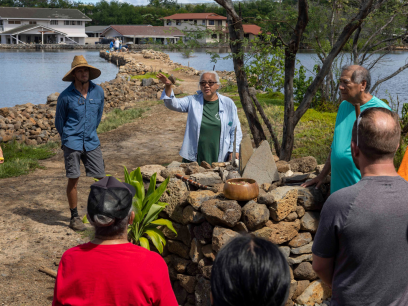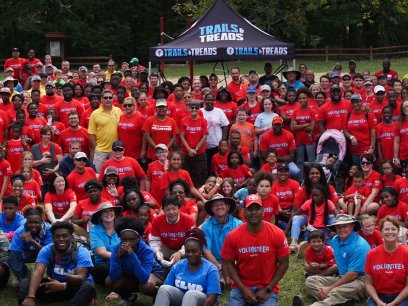
This year, discover the nation’s small parks during National Park Week. The week-long event kicks off on April 16 with a fee-free day, the perfect opportunity to visit a new-to-you park.
“Small” can be defined as the size of the park or the number of visitors. Explore a small park to learn something new and enjoy the benefits of spending time in nature without worrying about crowds. Smaller-size parks can also be easier for visitors of all physical abilities to enjoy.
Chances are, there’s a small park close to home. The National Park Service (NPS) system includes 423 areas covering more than 85 million acres located in every state, the District of Columbia, American Samoa, Guam, Puerto Rico, and the Virgin Islands. In addition to 63 national parks, NPS manages historic sites, monuments, seashores, rivers, preserves, and much more, large and small.
The Littlest Parks

National parks are famous for their wide open spaces, but some parks pack a lot of history or natural beauty into a relatively small area. Here’s a look at some of the smallest parks.
- Smallest National Park: At 90.96 acres, Gateway Arch National Park is the smallest National Park. The grounds include the famous arch, a museum charting the history of the city of St. Louis, and restored courtrooms. This site officially became a National Park in 2018 and was formerly known as the Jefferson National Expansion Memorial.
- Smallest National Monument: The .34-acre Belmont-Paul Women's Equality National Monument in Washington, DC, was the long-time epicenter of the women’s rights movement.
- Smallest National Preserve: The Tallgrass Prairie National Preserve in Kansas protects nearly 11,000 acres of tall grass prairie, which once covered 170 million acres of North America.
- Smallest National Recreation Area: The Boston Harbor National Recreation Area includes 34 islands and peninsulas ranging in size from less than one acre to 274 acres. Visitors can walk through a Civil War-era fort, explore tide pools, hike, camp, and swim.
- Smallest NPS Site Overall: The smallest site managed by NPS overall is the .02-acre Thaddeus Kosciuszko National Memorial in Philadelphia. Visit the home of the Polish general, military engineer, and American Revolutionary War freedom fighter.
Find Your Small Park
In 2021, 30% of all national parks recorded more than one million recreation visits. The popularity of public lands exploded during the COVID-19 pandemic as people flocked to the outdoors for exercise and rejuvenation in a safe, socially-distanced environment. (Curious about how many visitors your favorite park hosted last year? Explore visitor use statistics from NPS.)
With record visitation expected to continue at America’s most popular sites, now is a great time to hit the road less traveled to discover small parks. NPS recommends planning new experiences around clusters of less-visited parks.
One way to do this is to search for National Historic Parks near you. Inspiring sites like the New Orleans Jazz National Historical Park, Utah’s Golden Spike National Historical Park, and the Rosie the Riveter World War II Home Front National Historical Park in California are sure to give you a new perspective on our nation’s past.
NEEF’s Recommendations for Small Parks to Visit
Get inspired by this short list of less-visited small park alternatives to the country’s most popular national parks (in order of visitation). But don’t stop here—there are hundreds more to add to your bucket list.
1) Great Smoky Mountains ➡️ Cumberland Gap National Historical Park (Kentucky, Tennessee, Virginia)
Discover rich history, spectacular overlooks, unique rock formations, cascading waterfalls, and over 80 miles of hiking trails in Cumberland Gap National Historical Park's 24,000 acres. Plus: those famous smoky mountains at sunrise.
2) Zion ➡️ Dinosaur National Monument (Colorado, Utah)
Dinosaur National Monument offers so much to explore, from rafting down untamed rivers to hiking deep-walled canyons and desert mountains. Don’t miss the wall of 1,500 fossils on display at Quarry Exhibit Hall.
3) Yellowstone ➡️ Lassen Volcanic National Park (California)
Yellowstone is not the only NPS site with an eruptive past. Lassen Volcanic National Park’s hydrothermal features include fumaroles, mud pots, boiling pools, and steaming ground. Depending on the season, you can also cross-country ski, go boating, or take a 30-mile scenic mountain drive.
4) Grand Canyon ➡️ Black Canyon of the Gunnison National Park (Colorado)
Visit Black Canyon of the Gunnison National Park to see some of the steepest cliffs, oldest rock, and craggiest spires in North America. This unique vertical environment also offers great dark sky viewing conditions. The Painted Wall is the highest cliff in Colorado and stands taller than the Empire State Building.

5) Rocky Mountain ➡️ Katmai National Park and Preserve (Alaska)
Mountain vistas don’t get any wilder than Alaska. Discover the peninsula’s glaciers, volcanic geology, and over four million acres of wilderness. The park also famously hosts Fat Bear Week, an annual online event that showcases the importance of salmon and grizzly bears to Katmai's ecosystem.
6) Acadia ➡️ Katahdin Woods and Waters National Monument (Maine)
This new NPS unit preserves over 87,000 acres in Maine's North Woods. Drive the 17-mile scenic loop and try to spot black bears, Canada Lynx, moose, river otters, and other native species.
7) Grand Teton ➡️ North Cascades National Park (Washington)
Explore jagged peaks crowned by more than 300 glaciers, less than three hours from Seattle. Hike or climb the North Cascades to experience some of the finest mountain country in North America.
8) Yosemite ➡️ Big Bend National Park (Texas)
Peace and quiet are easy to come by deep in the heart of far west Texas. Stand in awe of temple-like canyons carved from ancient limestone by the Rio Grande. Learn about the area’s rich cultural history, including archeological sites dating back nearly 10,000 years.
9) Indiana Dunes ➡️ Voyageurs National Park (Minnesota)
Explore 218,055 acres of beautiful lake coastline by foot or by boat. This year-round adventure wonderland is full of dramatically exposed rock ridges, cliffs, wetlands, and forests.
How to Show Small Parks That You Care
As the popularity of outdoor recreation continues to rise, we can minimize our impact on parks of all sizes by following Leave No Trace principles. These seven principles have been adapted to apply anywhere and to almost every recreational activity, from remote wilderness areas and local parks to your own backyard. Here are a few additional ways you can get involved to protect small parks near you:
- Take the #RecreateResponsibly pledge to care for yourself, others, and the outdoors.
- Learn how to camp respectfully on public lands.
- Put your talents, knowledge, skills, and abilities to work for your local park by participating in the NPS Volunteers-In-Parks program.
- Give back to your local public lands by volunteering on National Public Lands Day, held annually on the fourth Saturday in September.


